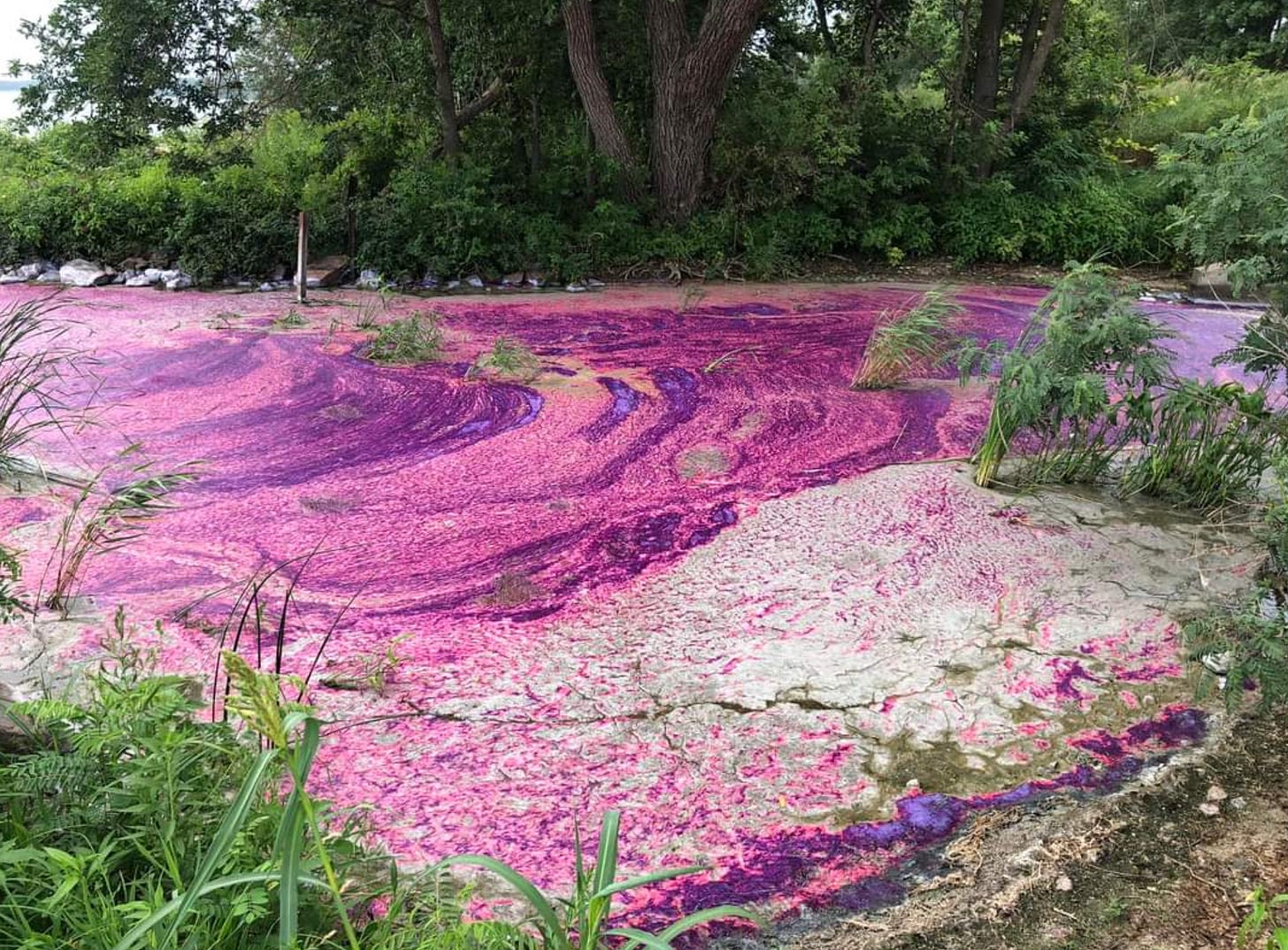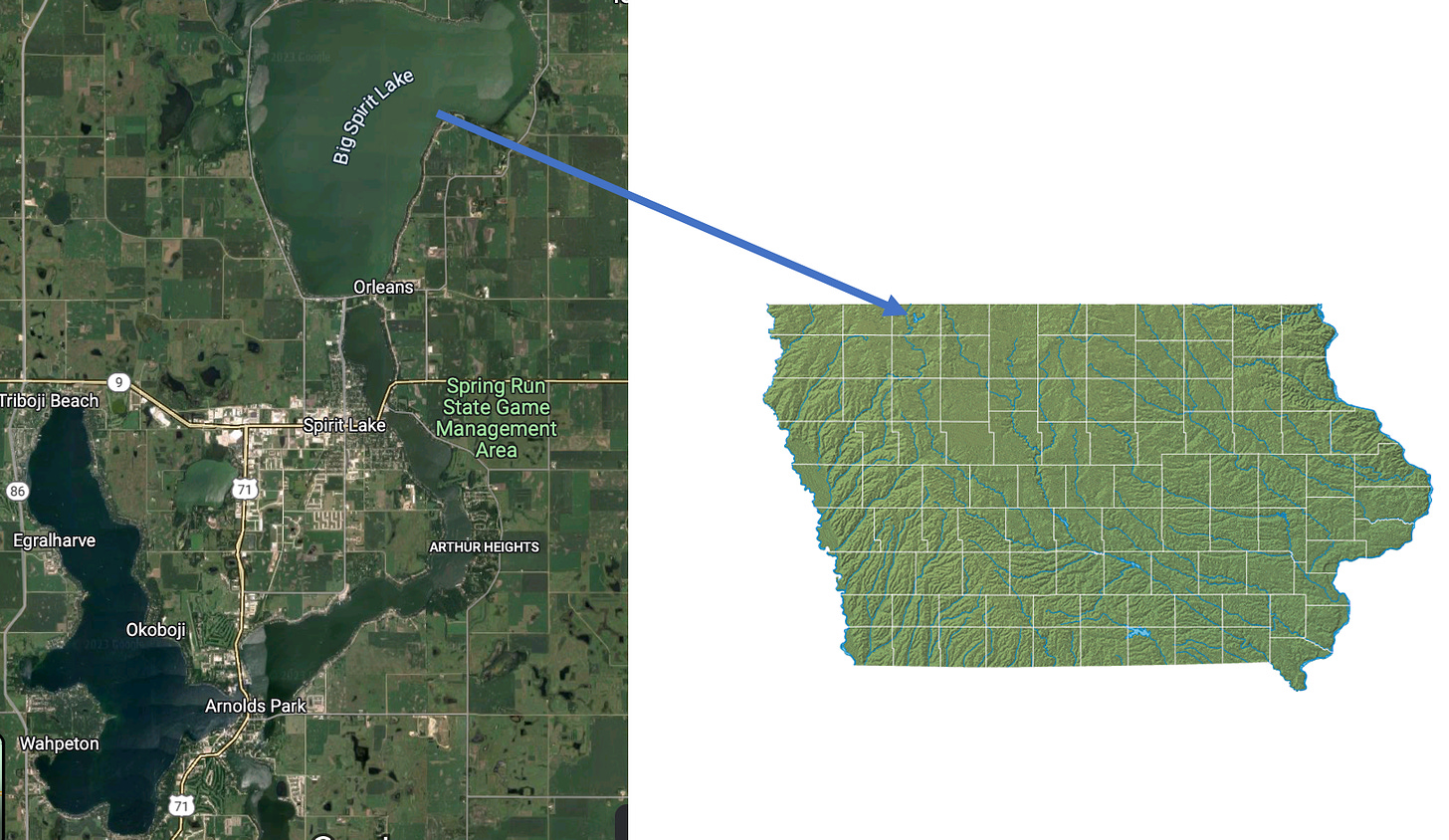Note: moments after I posted this piece, I saw a news story where Iowa DNR assigned the purple color to ‘sulfur bacteria’ propagating as a result of a dying cyanobacteria bloom. I’m not a position to dispute that. Retired microbiologist Mark Rasmussen also emailed saying this: “It is possible that is a bloom of purple sulfur bacteria. We would need to do a spectra of their photosynthetic pigments to know for sure.”
I’m leaving my original piece as is and you can consider this other information as you read it.
A recent photo of water in Iowa’s Spirit Lake was making the rounds on Twitter, oops, I mean X (my only question—Y?), and just in case you missed it, here it is.
The photo was posted by a fellow named Travis Schlenger and I contacted him to confirm its legitimacy, which he did, and he also told me that he did not take the photo but knew the person that did. The photographer declined attribution for this piece.
I knew immediately upon seeing this photo that it was likely the result of a cyanobacteria (blue-green algae) bloom, although naturally many people on Twixxer instinctively thought it was due to a chemical release.
Cyanobacteria are commonly called blue-green algae, but they aren’t really algae. All organisms on earth are either prokaryotes or eurkaryotes; cyanobacteria are prokaryotes, meaning, among other things, that they do not have a membrane-enclosed cell nucleus with genetic material. They do, however, have membrane-enclosed sacs where photosynthesis occurs. Thus you can think of these organisms as bacteria that can undergo that process to produce their own food.
These are some of first organisms to occupy earth, with evidence of their existence dating to 3.5 billion years ago. The oxygen in our atmosphere is largely the result cyanobacteria releasing it during their life processes. Cyanobacteria may also have been strong contributors to the formation of fossil crude oil (1).
During sunlight hours the cyanobacteria use CO2 and light energy to produce carbohydrates for energy storage. Since the organisms are in water, the CO2 is derived not from the atmosphere but from the water itself. At night, they ‘respire’, i.e. convert carbohydrates back to CO2 which releases energy.
A lake’s or river’s pH (a measure of acidity) is often-times controlled by CO2. Removing CO2 from the water column increases pH; release of CO2 lowers it. Explosive growth of cyanobacteria, made more likely by high nutrient (phosphorus and nitrogen) concentrations, warm temperatures and abundant sunshine, can cause the pH of a lake or stream to swing wildly—high in the day when cyanobacteria are gobbling up CO2 during photosynthesis and low at night when they’re burning carbohydrates for energy and releasing CO2. pH levels >10 during day and <7 at night are not unheard of during large blooms.
Although these organisms are ‘natural’ nearly everywhere on earth, our species’ habit of saturating our surroundings with waste nutrients has created an environment where cyanobacteria are happier than a butcher’s dog, as well as an environment where evolution has left other aquatic species unable to cope. For example, the pH swings. You might think a pH swing of 4 doesn’t sound like much, but it means a factor of 10,000 difference in the concentration of hydrogen ions in the water, meaning a fish or mayfly is swimming in milk of magnesia during the day and tomato juice at night. The water turbidity (cloudiness or opaqueness) caused by dense blooms leaves sight feeders like smallmouth bass unable to catch their prey, and means the light needed by desirable, multi-cellular aquatic plants is intercepted before they can use it for their own photosynthesis. These are ways that species assemblages and aquatic ecosystems are disrupted by the nutrient pollution from corn belt farming.
Back to Fear It Lake. The peculiar thing about this bloom was the color—pink/purple/white. Although the cyanobacteria name implies a cyan color, the great variety of different cyanobacteria species can also produce a large variety of colors. The cyanobacteria genus Planktothrix is known to produce these colors, as well as the toxic group of compounds known as microcystins, which cause various diseases in human beings through contact or ingestion. Dogs also seem to be particularly vulnerable to cyanobacteria toxins. Spirit Lake’s shallow depth and surrounding agriculture have long made the lake vulnerable to cyanobacteria blooms; the only lake in the Iowa Great Lakes region that doesn’t have a chronic cyanobacteria problem is West Okoboji; it’s great depth (136’) entombs nutrients (especially phosphorus) leaving it unavailable for cyanobacteria.
Iowa DNR does monitor many lake beaches for microcystin and beaches are posted and closed because of it. Cyanobacteria don’t always produce microcystin or other toxins and an individual bloom may start and stop production based on changing weather and water chemistry conditions. Both the bloom themselves and the production of toxins are hard to predict.
About my book: The Swine Republic is a collection of essays about the intersection of Iowa politics, agriculture and environment, and the struggle for truth about Iowa’s water quality. Longer chapters that examine ‘how we got here’ and ‘the path forward’ bookend the essays. Foreword was beautifully written by Tom Philpott, author of Perilous Bounty. Get a free copy of the book with an annual paid subscription to this substack ($30 value).
Purchase The Swine Republic
Radwan, S.S. and Al-Hasan, R.H., 2000. Oil pollution and cyanobacteria. In The ecology of cyanobacteria: their diversity in time and space (pp. 307-319). Dordrecht: Springer Netherlands.







Sometimes it's neither cyanobacteria nor sulfur bacteria but rather the local car wash dumping their wastewater into the nearest storm sewer.
https://www.thegazette.com/environment-nature/what-turned-a-coralville-creek-pink/